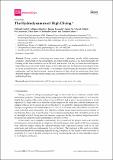The hydrodynamics of high diving
Author(s)
Guillet, Thibault; Mouchet, Mélanie; Belayachi, Jérémy; Fay, Sarah (Sarah C.); Colturi, David; Lundstam, Per; Hosoi, Peko; Clanet, Christophe; Cohen, Caroline; ... Show more Show less
Downloadproceedings-49-00073.pdf (1.145Mb)
Publisher with Creative Commons License
Publisher with Creative Commons License
Creative Commons Attribution
Terms of use
Metadata
Show full item recordAbstract
Diving consists of jumping into water from a platform, usually while performing acrobatics. During high diving competitions, the initial height reaches 27 m. From this height, the crossing of the water surface occurs at 85 km/h, and as such it is very technical to avoid injuries. Major risks occur due to the violent impact at the water entry and the formation and collapse of the air cavity around the diver. In this study, we investigate experimentally the dynamics of the jumper underwater and the hydrodynamic causes of injuries in high dives by monitoring dives from different heights with high-speed cameras and accelerometers in order to understand the physics underlying diving.
Date issued
2020-06Department
Massachusetts Institute of Technology. Department of Mechanical EngineeringJournal
Conference of the International Sports Engineering Association
Publisher
Multidisciplinary Digital Publishing Institute
Citation
Guillet, Thibault et al. "The hydrodynamics of high diving." 13th Conference of the International Sports Engineering Association, June 22-26, 2020, online. Proceedings 49, 1 (June 2020): 73 ©2020 Author(s)
Version: Final published version
ISSN
2504-3900